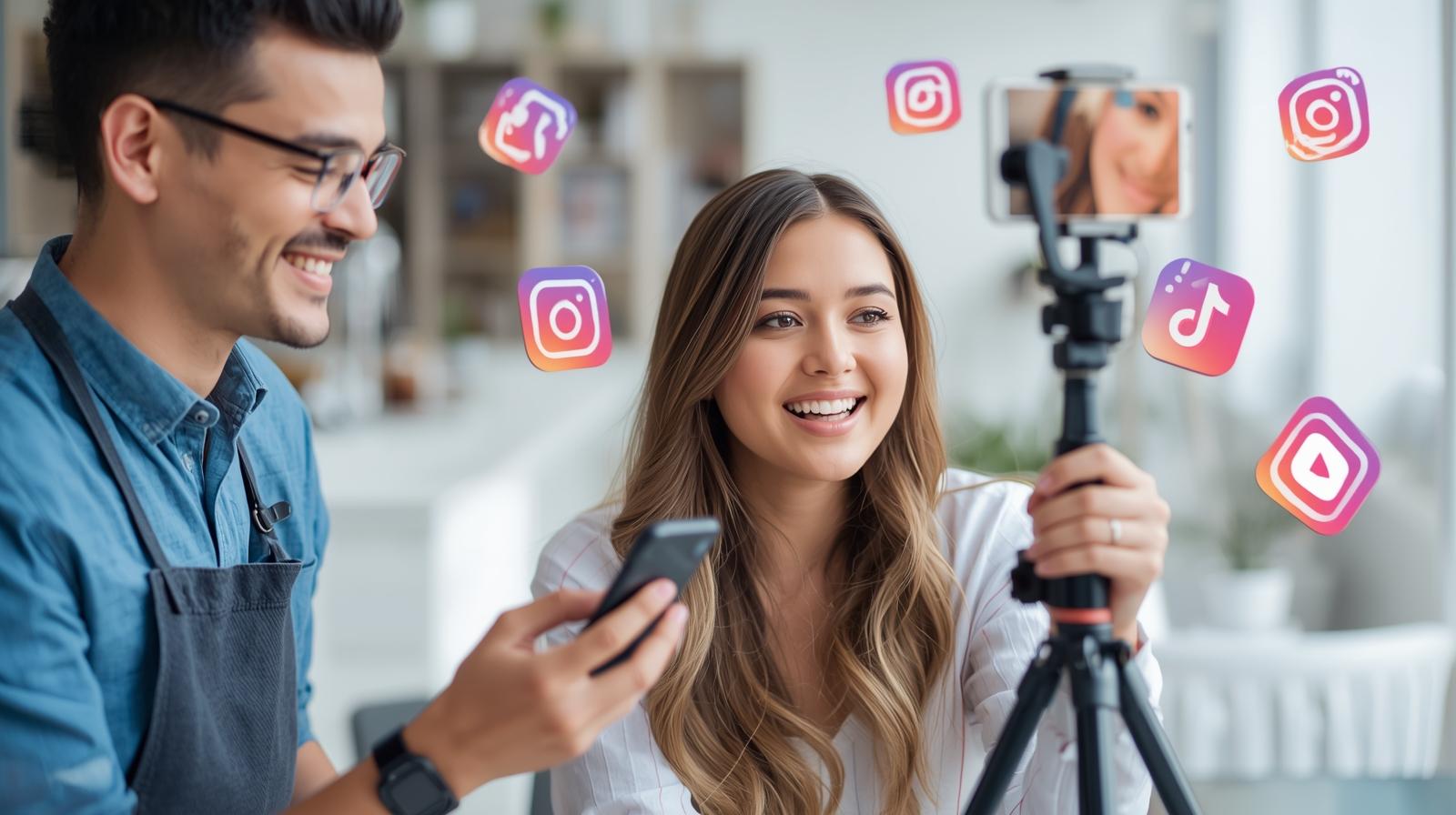Introduction
Imagine scrolling through Instagram or TikTok and seeing a new brand pop up—not the usual corporate giants, but a small, scrappy business making waves. You pause, click, and eventually make a purchase. In that moment, you’ve experienced the magic of influencer campaigns.
For small businesses, competing with big brands can feel like David facing Goliath. However, here’s the secret: you don’t need a Fortune 500 budget to win attention.
With the right influencer marketing strategies, even the tiniest startups can create buzz, build trust, and grow faster than you’d think.
In this article, I’ll show you exactly how small businesses can compete with big brands using influencer campaigns—step by step.
What Are Influencer Campaigns?
At their core, influencer campaigns are collaborations between brands and individuals who have a strong following on social media.
Moreover, these influencers are trusted voices in their communities, promoting products or services in ways that feel authentic, relatable, and entertaining.
In fact, think of it as word-of-mouth marketing on steroids. Instead of a friend telling ten people about your brand, an influencer could tell tens of thousands… maybe even millions. Because followers trust influencers’ opinions, their endorsements often carry more weight than traditional ads.
Above all, influencer are not just about posting pictures—they’re about building trust, creating engagement, and telling a story.
Authenticity is paramount: the influencer’s audience should feel they genuinely love your product, not just got paid to say something nice.

Why Small Businesses Should Invest in Influencer Campaigns
You might think influencer marketing is only for big brands—but that’s not true. Small businesses can leverage influencer campaigns to achieve the following:
-
Reach targeted audiences without massive advertising budgets
-
Boost brand credibility quickly by being associated with someone the audience already trusts
-
Create engaging content that resonates with your customers
-
Drive measurable results like clicks, conversions, and social media engagement
Therefore, even with limited resources, small businesses can make a huge impact. This is because they can carefully select influencers who align with their brand and values.
Types of Influencer Marketing
Influencer campaigns come in different shapes and sizes. Choosing the right type depends on your goals, budget, and platform.
1. Sponsored Posts
You pay an influencer to feature your product or service. Sponsored posts are flexible—they can be a single photo, carousel, or short video.
Example: A fitness micro-influencer posts a 30-second reel using your workout gear, tagging your brand and linking to your online store.
2. Product Gifting
Alternatively, this budget-friendly approach involves sending products to influencers for free, hoping they share their honest review. Product gifting can yield authentic content and build goodwill.
Example: A handmade soap company sends a gift box to eco-conscious influencers, who then share unboxing videos with their audience.
3. Ambassador Programs
Long-term partnerships where influencers consistently promote your brand. This builds continuity, loyalty, and ongoing engagement.
Example: A boutique coffee brand partners with a micro-influencer to post weekly coffee recipes, creating familiarity with their audience.
4. Content Collaborations for Influencer Marketing
Co-create content with influencers, like tutorials, challenges, or giveaways. This strategy boosts engagement and taps into trending topics.
Example: A small clothing brand teams up with an influencer to run a “Style Your Outfit Challenge” on TikTok, encouraging followers to share content featuring your products.
Key Takeaway:
The magic of influencer campaigns lies in authentic storytelling and targeted reach. Small businesses can use these strategies to make a big impact—even outshining the big brands.

Benefits of Influencer Marketing for Small Businesses
Influencer marketing isn’t just a luxury for big brands—it’s a game-changer for small businesses. With the right strategy, even a tiny startup can gain massive exposure, build trust, and drive sales.
1. Affordable Marketing That Actually Works
Indeed, partnering with micro- and nano-influencers can reach highly engaged audiences at a fraction of the cost of traditional ads.
Example: A small candle business partnered with five micro-influencers on Instagram. They spent $500 but reached 50,000 potential customers and saw a 20% boost in sales.
2. Authenticity Builds Trust
People trust people, not brands. Influencers have already earned their audience’s trust, making their recommendations more powerful.
Anecdote: I once tried a local coffee brand simply because a foodie influencer raved about it. I didn’t even know the brand existed before that post!
3. Brand Awareness on Steroids
Influencers help you reach audiences you might never access otherwise. Even a single well-crafted post can introduce your brand to thousands.
| Benefit | How It Works | Example |
|---|---|---|
| Affordable marketing | Partner with micro/nano-influencers | $100 campaign reaching 10K users |
| Authenticity & trust | Influencers give genuine recommendations | Followers trust product reviews |
| Brand awareness | Rapid exposure to new audiences | TikTok challenge goes viral |
| Community building | Connect with niche groups | Eco-conscious influencers promote products |
4. Build Long-Lasting Community Connections
Influencers often represent niche communities. Partnering with the right people helps your business connect with targeted audiences genuinely interested in your products.
Example: A small skincare brand collaborated with eco-friendly influencers. Posts generated sales and built a loyal online community.
5. Measurable Results
Digital influencer campaigns are trackable. Metrics like engagement, clicks, conversions, and sentiment show what’s working.
Example: Using UTM links, a small fashion brand found TikTok videos drove 40% more traffic than Instagram posts.
6. Storytelling That Sticks
Influencers tell your brand story in a relatable way. People love supporting brands with a unique mission or perspective.
Tip: Share your journey—whether it’s a family bakery or handmade jewelry business—and let influencers amplify it authentically.
Types of Influencers and How to Find Them
Influencer Tiers
| Type | Followers | Cost | Engagement | Best For |
|---|---|---|---|---|
| Nano | 1K–10K | Free–$100 | Very High | Niche audience, product testing |
| Micro | 10K–100K | $100–$500 | High | Authentic promotion, awareness |
| Macro | 100K–1M | $500–$5K | Medium | Broader reach, social proof |
| Mega | 1M+ | $5K+ | Low–Medium | Huge reach, brand prestige |
Key Insight: Nano- and micro-influencers are ideal for small businesses—they’re affordable, engaged, and trusted.

How to Find the Right Influencers
-
Identify Your Audience: Who are your customers? Which platforms do they use?
-
Check Engagement: Note that smaller audiences with high engagement are more valuable than large, inactive followings.
-
Look for Content Alignment: Also ensure the influencer’s style matches your brand’s tone and visuals.
-
Review Past Collaborations: Additionally, see if they’ve successfully promoted similar products.
-
Use Tools: AspireIQ, Heepsy, and Upfluence streamline influencer discovery and outreach.
Pro Tips:
-
Start small: Test with 1–2 micro-influencers before scaling.
-
Consider local influencers for physical stores.
-
Explore TikTok, YouTube, Pinterest beyond Instagram.
-
Track all campaigns with UTM links or promo codes.
Anecdote:
A small skincare brand worked with three micro-influencers. Within two months, they reached 45K people, increased traffic by 70%, and sold out their first batch—spending less than $600!
Key Takeaway:
The secret isn’t spending more—it’s strategically choosing influencers whose followers care about your niche.
Measuring Success of Influencer Campaigns
Track these key metrics:
-
Engagement rate (likes, comments, shares)
-
Click-through rate (CTR) on links
-
Conversions (sales, sign-ups)
-
Reach and impressions
-
Brand sentiment (positive vs negative feedback)
Platforms That Work Best for Influencer Campaigns
Choosing the right platform is crucial to reach your target audience effectively.
Instagram Influencer Campaigns
Best for lifestyle, fashion, beauty, and food brands. Use photos, reels, and stories to showcase products. Focus on micro-influencers and include shoppable links or promo codes.
Example: A boutique clothing brand used Instagram reels with micro-influencers, boosting website traffic by 30%.
TikTok Influencer Campaigns
Ideal for viral challenges, trends, and Gen Z audiences. Encourage fun, creative content and trending hashtags. Authentic storytelling works better than direct selling.
For instance, a handmade soap brand created a “Morning Self-Care Challenge,” driving thousands of views and online sales.
YouTube Influencer Campaigns
Great for tutorials, reviews, and long-form content. Influencers can demonstrate products in depth and include links to your store.
For example kitchenware brand partnered with YouTubers for how-to videos, increasing traffic and conversions.
Facebook Influencer Marketing
Works well for community-focused marketing and older demographics. Use Groups, Live sessions, and personal stories to engage audiences.
Example: A local fitness studio hosted a Facebook Live workout, boosting class sign-ups and engagement.
Pinterest Influencer Campaigns
Perfect for visually-driven products like home decor, crafts, and fashion. Influencers can create boards and pins with links to your site.
For example, handmade jewelry brand collaborated on a “Gift Ideas” board, increasing website visits during Mother’s Day.

Common Mistakes to Avoid in Influencer Campaigns
Even the best-laid influencer strategies can stumble if you fall into common traps. Here’s what to watch out for:
1. Choosing Influencers in Your Campaign Based on Followers Alone
It can be tempting to chase big numbers, but follower count doesn’t equal impact. A mega-influencer with millions of followers may have low engagement, meaning few people actually see or act on their posts.
Tip: Focus on micro- and nano-influencers with smaller, highly engaged audiences. Their followers are more likely to trust recommendations and take action.
For instance, a small jewelry brand partnered with a micro-influencer with 15K followers but 8% engagement. Their campaign led to more sales than working with a macro-influencer with 200K followers but only 1% engagement.
2. Ignoring Engagement Metrics in Influencer Campaigns
Engagement metrics—likes, comments, shares, and saves—are more important than vanity metrics like follower count. Low engagement indicates your content may not resonate with the audience.
Tip: Look at average engagement rates, comment quality, and post interactions before committing.
Example: A skincare startup initially partnered with an influencer who had many followers but very low engagement. Switching to a smaller influencer with an active community doubled their website traffic.
3. Setting Clear Goals for Your Influencer Campaigns
Without clear objectives, campaigns can drift aimlessly, wasting time and money. Are you trying to boost brand awareness, generate sales, or grow your social media following?
Tip: Set SMART goals (Specific, Measurable, Achievable, Relevant, Time-bound) for every campaign.
Example: Instead of “get more sales,” set a goal like: “Increase Instagram-driven sales by 15% in 30 days via influencer posts.”
4. Not Tracking Results or ROI
If you don’t track performance, you won’t know what works. This makes it impossible to optimize future campaigns.
Tip: Use UTM links, promo codes, and analytics tools to track clicks, conversions, and engagement. Regularly review these metrics and adjust your strategy.
Example: A boutique coffee brand tracked influencer posts using unique discount codes. They discovered TikTok videos converted 3x better than Instagram posts and adjusted their strategy accordingly.
5. Over-Controlling Influencer Content
Trying to script every post can kill authenticity. Influencers’ audiences follow them for their unique voice and style—if your campaign feels forced, it may backfire.
Take for example, a small handmade soap company initially dictated every caption, resulting in awkward posts. After allowing influencers to speak in their own voice, engagement doubled and comments were more positive.
Competing With Big Brands
Focus on creativity, authenticity, and strategy:
-
Target niche audiences overlooked by big brands
-
Partner with micro- and nano-influencers for genuine connections
-
Leverage trending platforms to go viral on a small budget
-
Offer personalized experiences big brands can’t replicate
-
Highlight your story and values
Conclusion
Influencer campaigns aren’t just for big brands. With planning, creativity, and smart partnerships, small businesses can compete, thrive, and grow online.
Above all, authenticity always wins—making your small brand feel just as big as the giants. With Alphanetx influencer campaigns, you can get started with the right strategies and partnerships. So, start with a micro-influencer today and watch your brand awareness soar!


